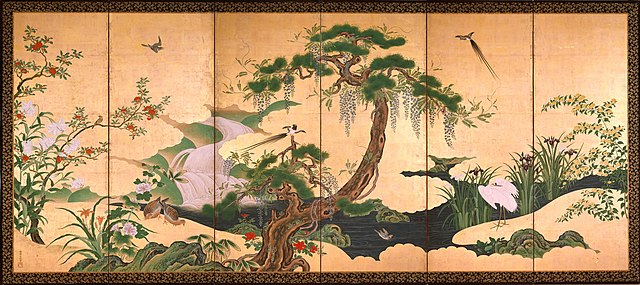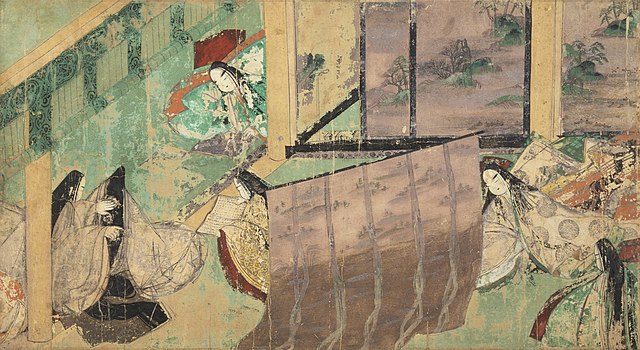The Kanō school is one of the most famous schools of Japanese painting. The Kanō school of painting was the dominant style of painting from the late 15th century until the Meiji period which began in 1868, by which time the school had divided into many different branches. The Kanō family itself produced a string of major artists over several generations, to which large numbers of unrelated artists who trained in workshops of the school can be added. Some artists married into the family and changed their names, and others were adopted. According to the historian of Japanese art Robert Treat Paine, "another family which in direct blood line produced so many men of genius ... would be hard to find".
Birds and Flowers of Spring and Summer, Kanō Einō
Pair of screens with tigers scared by a storm-dragon by Kanō Sanraku, 17th century, each 1.78 × 3.57 metres.
Zhou Maoshu Appreciating Lotuses A hanging scroll painted by Kanō Masanobu
Tokugawa Yoshinobu in the Kuroshoin of the Ninomaru palace of Nijō Castle, showing a fully decorated hall, Tanryō Murata [ja]
Japanese painting is one of the oldest and most highly refined of the Japanese visual arts, encompassing a wide variety of genres and styles. As with the history of Japanese arts in general, the long history of Japanese painting exhibits synthesis and competition between native Japanese aesthetics and the adaptation of imported ideas, mainly from Chinese painting, which was especially influential at a number of points; significant Western influence only comes from the 19th century onwards, beginning at the same time as Japanese art was influencing that of the West.
Set of sliding doors of Frolicking Birds in Plum and Willow Trees by Kanō Sansetsu, 1631, Important Cultural Property
Mural painting from the Takamatsuzuka Tomb. National Treasure.
Panel from The Tale of Genji handscroll (detail). National Treasure.
Siege of Sanjō Palace




![Tokugawa Yoshinobu in the Kuroshoin of the Ninomaru palace of Nijō Castle, showing a fully decorated hall, Tanryō Murata [ja]](https://upload.wikimedia.org/wikipedia/commons/thumb/e/e2/Taisei_H%C5%8Dkan.jpg/547px-Taisei_H%C5%8Dkan.jpg)



